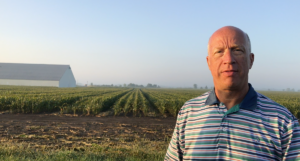This Week In Ag #130
“The World’s Fair of Agriculture” commences this week. This marks the 72nd year for the Farm Progress Show, the biggest and most famous of farm shows. I’ve lost track of the number of shows I’ve attended; it’s been dozens. I even worked at it as an intern for Prairie Farmer magazine. But I’ll always remember my first. It was 1972, held in my hometown of Galesburg, Illinois. Not just in my hometown, mind you, but just a country block from us, at the farm owned by my grandparents’ best friends, Hank and Grace Inness. My parents were best friends with their son and his wife; I was best friends with their son.
This was the biggest FPS in history at that time, drawing over 360,000 attendees. Even though I was very young, the memories are still vivid.
We were on the precipice of US farming’s golden age. Fueled by a grain deal with the Soviet Union, we ushered in the Export Era. Grain prices would triple during the next two years. We were encouraged to grow crops “fence row to fence row” to meet unprecedented global demand. There were a million more farmers than today. Nearly every farm had grain and livestock. You could raise a family on a few hundred acres. And a 1,000-acre farm was considered very big.
Back then, FPS rotated annually between Iowa, Illinois and Indiana. A host family(s) was selected to hold the show on their farm and planning began over a year in advance. It was a tremendous honor to serve as a host family. Nowadays, the show rotates between permanent sites in Decatur, IL, and Boone, IA.
Since ‘72 was an election year, you saw lots of campaign buttons/signage for Nixon and McGovern (believe it or not, Illinois was actually a battleground state in those days). Dignitaries in attendance included Vice President Spiro Agnew, Governor Richard Ogilvie, and US Ag Secretary Earl Butz (ironically, a decade later, I would serve as his personal chauffeur while in college).
Our community benefited greatly from the show, as hotels and restaurants were packed. Local vendors and civic groups were contracted to provide food and services. Our family benefited, too. Since we had land en route to the show, we received lots of free seed and chemicals. All we had to do was put out signs. Dad and Uncle Gary were more than happy to accommodate.
Farm Progress has always been an iron show, no more evident than in those days. The stars of the show – that everyone scurried to see – were the high-horsepower tractors; the black color of their billowing clouds of smoke surpassed only by the dark soil they turned over with their moldboard plows. Powerful, super-heavyweight 4-wheel drive tractors were the new rave. Fuel consumption was an afterthought. Soil compaction and erosion a non-considerations. Tent city was flooded with dozens of seed corn and chemical brand booths, each passing out hats and other cool giveaways faster than grandmas pass out pancakes.
For me, the most memorable image from the show was seeing a cow walking around with a window on its side. You read that correctly. Via a special surgical procedure, a fistula is created that serves as a pothole into a bovine’s rumen. It allows veterinarians and scientists to study the cow’s digestive system. Given today’s culture, it’s doubtful you’ll see many cows with windows publicly paraded around at this year’s show. Call it a relic from the past. Like free admission to the show.
Related Posts

This Week in Ag #28
The recent fertilizer market may be best described by two catch phrases: “wait-and-see” and “just in time.” In the fall of 2021, sky-rocketing energy prices pointed toward looming inflation and an inevitable rise in fertilizer prices. Many savvy growers, including those aligned with the regen ag movement, hedged their bets by purchasing crop nutrients that

This Week in Ag #22
Twenty years ago, I found myself in the position of operating a farm all by myself. My father, who I was farming with, passed away suddenly that January. So in addition to my full-time ag marketing job, I was flying solo across my family farm in western Illinois.

Open, With Care: A Video Message From Bio Huma Netics
BHN Operation Team Message from BHN_Vimeo on Vimeo. At Bio Huma Netics, Inc., our Operations Team realizes the incredible challenges that are in the world today, and we are doing everything in our power to better serve you. From the start of the crises, our Team has focused on keeping our employees, customers, families,

